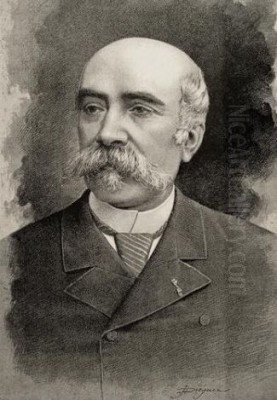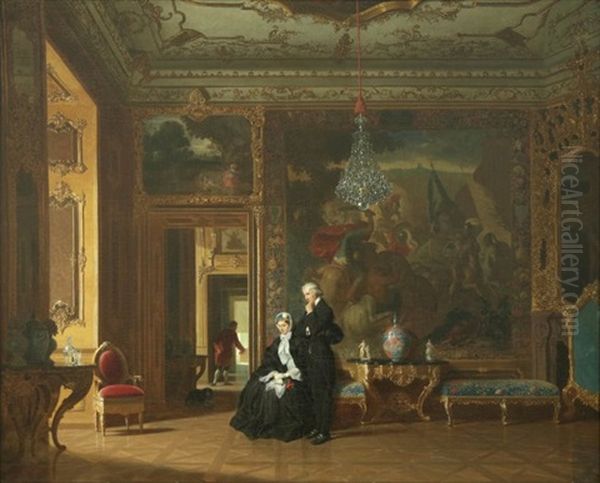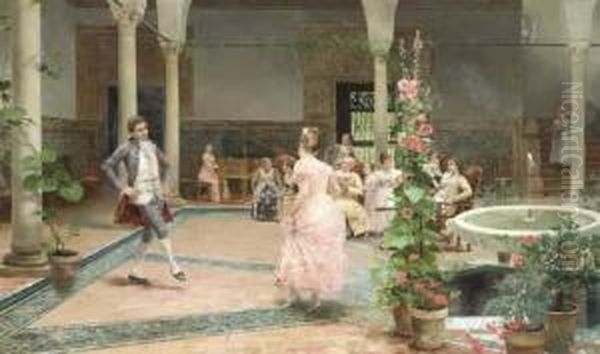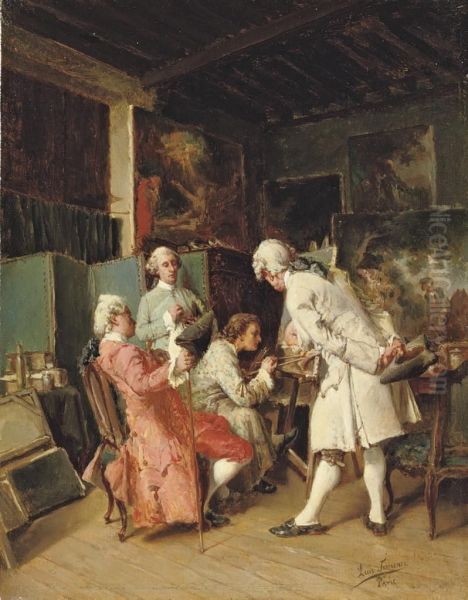
Luis Jiménez y Aranda stands as a significant figure in late 19th and early 20th-century Spanish art, particularly noted for his mastery of the Realist style and his successful career centered largely in Paris. Born into an artistic milieu in Seville, he navigated the transitions in European art, establishing a reputation for detailed genre scenes and socially conscious subjects that earned him international acclaim. His life and work offer a fascinating glimpse into the world of a Spanish painter thriving abroad during a period of rich artistic exchange and evolution.
Early Life and Artistic Formation in Seville
Luis Jiménez y Aranda was born in Seville, Spain, in 1845. This Andalusian capital, with its rich artistic heritage deeply rooted in the Spanish Golden Age masters like Diego Velázquez and Bartolomé Esteban Murillo, provided a fertile ground for his initial artistic development. He received formal training at the Royal Academy of Fine Arts in Seville (Real Academia de Bellas Artes de Santa Isabel de Hungría), an institution that upheld the traditions of academic draftsmanship and composition.
Crucially, Luis was not the only artist in his family. His elder brother, José Jiménez Aranda (1837-1903), was already an established and highly respected painter. José undoubtedly served as an early mentor and significant influence on Luis. While distinct artists with their own careers, the fraternal connection likely provided Luis with guidance and an entry point into the artistic circles of Seville. José himself drew inspiration from Spanish masters like Francisco Goya and Velázquez, and his focus on historical and genre scenes would resonate in Luis's later work.
Further broadening his horizons, Luis traveled to Rome, a traditional destination for aspiring European artists seeking to study classical antiquity and Renaissance masters. During his time in Italy, he connected with Mariano Fortuny y Marsal, another Spanish painter who had achieved immense international fame. Fortuny's dazzling technique, characterized by vibrant light, meticulous detail, and often featuring Orientalist or historical genre themes (known as tableautin), captivated the European art market. Exposure to Fortuny and the expatriate artist community in Rome would have further shaped Luis's ambitions and technical approach.
The Parisian Nexus: Relocation and Recognition

Around the mid-1870s, Luis Jiménez y Aranda made the pivotal decision to move to Paris, the undisputed center of the Western art world. This relocation marked a new chapter in his career, placing him amidst the dynamic and competitive Parisian art scene. While Impressionism was making waves, the official Salons and the broader art market still largely favored Academic and Realist traditions, providing fertile ground for an artist with Jiménez y Aranda's skills.
A significant step in establishing his career in France occurred in 1874 when he established contact with Adolfo Goupil. Goupil was one of the most influential art dealers of the 19th century, heading the powerful firm Goupil & Cie. This gallery handled works by many leading academic painters, such as Jean-Léon Gérôme and William-Adolphe Bouguereau, and played a crucial role in disseminating art through reproductions. Forging a relationship with Goupil was a strategic move, providing Jiménez y Aranda with access to a prestigious platform and the international clientele Goupil commanded. This "profitable connection" was instrumental in building his reputation outside Spain.
In Paris, Jiménez y Aranda also became part of the vibrant community of Spanish expatriate artists. He formed a close friendship with Emilio Sánchez Perrier, a fellow Andalusian painter known primarily for his evocative landscapes, often influenced by the Barbizon School. The two artists shared a studio in the Montparnasse district, a hub for artistic activity. This camaraderie provided mutual support and likely involved artistic exchange, potentially influencing Jiménez y Aranda's approach to light and atmosphere, particularly in his depictions of outdoor scenes or settings incorporating natural light.
Artistic Style and Thematic Concerns
Luis Jiménez y Aranda remained fundamentally a Realist painter throughout his career. His Spanish training instilled in him a strong emphasis on accurate drawing, careful composition, and a high degree of finish. His works are characterized by meticulous attention to detail, capturing textures, fabrics, and facial expressions with remarkable precision. This technical proficiency aligned well with the expectations of the Paris Salon and the tastes of collectors who appreciated skillful representation.
However, his style was not static. Living and working in Paris exposed him to contemporary trends, including Naturalism and the burgeoning Impressionist movement, spearheaded by artists like Claude Monet and Edgar Degas. While he never fully embraced Impressionism's radical dissolution of form, some of his later works, particularly those depicting everyday life and labor, show a tendency towards a brighter palette and perhaps a slightly looser brushstroke, possibly influenced by friends like Sánchez Perrier or the general artistic atmosphere.

His thematic choices often revolved around genre scenes – depictions of everyday life, both historical and contemporary. He excelled at narrative paintings that told a story or captured a specific social moment. A significant aspect of his work was its engagement with social realism. He frequently depicted scenes of labor, such as laundresses at work, or scenes set in public spaces like markets (A Market Scene). These works often carried an implicit commentary on social conditions, class distinctions, and the lives of ordinary people, aligning him with a broader European trend seen in the work of French artists like Gustave Courbet or Jean-François Millet, albeit often presented with less overt political charge. His Parisian scenes, like Une Parisienne en 1889, captured the character of the modern city.
Masterpiece: A Hospital Ward and the 1889 Exposition
The pinnacle of Luis Jiménez y Aranda's public recognition came with his painting The Visit of the Chief Physician to the Hospital Room (also referred to as A Hospital Room during the Visit of the Chief Physician or similar variations). This large-scale work exemplifies his mature style, combining meticulous realism with a compelling narrative and social dimension. The painting depicts a senior doctor making his rounds in a hospital ward, observed by staff and patients. The scene is rendered with clinical precision, capturing the stark environment of the hospital, the varied conditions of the patients, and the professional demeanor of the medical personnel.
The painting was exhibited at the Exposition Universelle held in Paris in 1889, a major international event celebrating French culture, industry, and the centenary of the French Revolution. Within the vast art exhibition housed at the Palais des Beaux-Arts, Jiménez y Aranda's painting stood out. It was awarded a Gold Medal, a significant honor that cemented his international reputation. The success of this work highlighted his ability to tackle complex, multi-figure compositions and to imbue a contemporary, almost documentary subject with artistic weight and dignity. The theme itself – modern medicine and institutional care – was a topic of growing interest in the late 19th century, reflecting societal changes and advancements.
The acclaim received for the hospital scene underscored Jiménez y Aranda's position as a leading figure among the Spanish painters working in Paris and a respected exponent of the Realist tradition on the international stage. It demonstrated that academic skill, when applied to contemporary subjects with sensitivity and insight, could still command attention and admiration even as avant-garde movements were challenging established norms.
Later Career, Legacy, and Contemporaries

Following the success of 1889, Luis Jiménez y Aranda continued to work and exhibit, primarily dividing his time between Paris and Pontoise, a town northwest of the capital that had also attracted Impressionist painters like Camille Pissarro. He remained active in the Paris Salons during the 1890s, presenting works that often depicted scenes of Parisian life and continued his exploration of genre and social themes. His output maintained a high standard of technical execution, reinforcing his reputation for craftsmanship.
He passed away in Pontoise, France, in 1928, having spent a significant portion of his productive life in his adopted country. His legacy resides in his contribution to the Spanish Realist school, particularly its manifestation abroad. He successfully bridged the meticulous traditions of his Sevillian training with the cosmopolitan environment of Paris, adapting his subjects and subtly evolving his style while remaining true to his realist foundations.
It is essential to consistently distinguish Luis Jiménez y Aranda (1845-1928) from his elder brother, José Jiménez Aranda (1837-1903). While both were accomplished painters from Seville who achieved recognition, they were distinct individuals with separate careers, styles, and trajectories, even though José likely served as an early influence on Luis.
Luis Jiménez y Aranda worked during a rich period in European art. His contemporaries included not only his friend Emilio Sánchez Perrier and the influential Mariano Fortuny, but also other successful Spanish painters active in Paris, such as the portraitist Raimundo de Madrazo y Garreta. He exhibited alongside dominant French academic figures like Gérôme, Bouguereau, and the master of military scenes, Ernest Meissonier. While perhaps not a direct competitor in the same vein as fellow Spaniard Joaquín Sorolla, who also achieved great fame and won awards at international exhibitions like the 1889 Expo, Jiménez y Aranda operated within the same competitive sphere of the official Salons and the international art market facilitated by dealers like Goupil. His work provides a valuable counterpoint to the Impressionist revolution, demonstrating the continued vitality and evolution of Realism in the late 19th century. The mention of Manuel Acosta as an early influence, while less documented, points to the network of artists within the Spanish context that shaped his beginnings.
Conclusion
Luis Jiménez y Aranda represents a compelling example of a Spanish artist who successfully navigated the international art world of the late 19th and early 20th centuries. Rooted in the strong realist tradition of Seville, mentored by his accomplished brother José, and inspired by figures like Fortuny, he established a significant career in Paris. His association with the dealer Adolfo Goupil and his friendship with contemporaries like Emilio Sánchez Perrier facilitated his integration into the Parisian scene. His art, characterized by meticulous detail, strong narrative content, and an engagement with social realism, earned him critical acclaim, culminating in the Gold Medal for his hospital ward painting at the 1889 Exposition Universelle. While perhaps less known today than some of his avant-garde contemporaries, Luis Jiménez y Aranda's work remains a testament to the enduring power of Realism and offers a valuable perspective on the artistic exchanges between Spain and France during a pivotal era in art history.